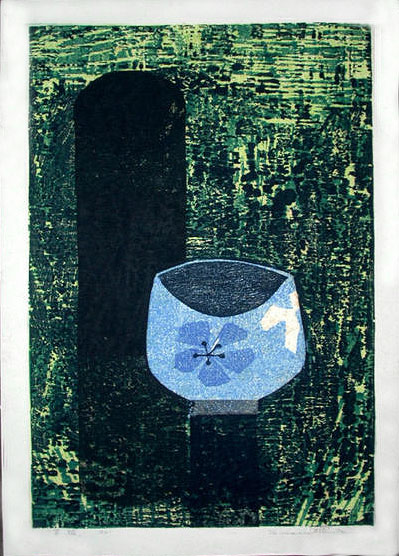 |
Shima Tamami
Woodcut, tea bowl, 1961 (415 x 300 mm)

"Tamami Shima" pencil signature (1960)
|
|
_460w.jpg) Shima Tamami (島珠実 1937-1999) was born in Hirosaki, Aomori prefecture. A graduate of the Women's College of Fine Arts (Tokyo) in 1958. she joined the Joryû Hanga Kyôkai (女流版画協会) Women’s Print Association; also called Nihon Joryū Hanga Kyōkai, 日本女流版画協会) in 1959, a groundbreaking society of female artists who staged exhibitions of their work for ten years (1956-1965). Shima contributed prints to their fourth show held in the seventh-floor gallery of the Toyoko Department Store in Shibuya, Tokyo. Shima Tamami (島珠実 1937-1999) was born in Hirosaki, Aomori prefecture. A graduate of the Women's College of Fine Arts (Tokyo) in 1958. she joined the Joryû Hanga Kyôkai (女流版画協会) Women’s Print Association; also called Nihon Joryū Hanga Kyōkai, 日本女流版画協会) in 1959, a groundbreaking society of female artists who staged exhibitions of their work for ten years (1956-1965). Shima contributed prints to their fourth show held in the seventh-floor gallery of the Toyoko Department Store in Shibuya, Tokyo.
Shima's prints were promoted in the West after she received a travel grant from the College Women's Association of Japan in 1962. Her inclusion as a prize winner in James Michener's 1962 iconic (at least in the West) book and print portfolio (see image at right and ref. below) in the same year also made her work more familiar outside of Japan.
It appears that Shima's inclusion in the Michener portfolio is the most commonly cited of her achievements, as very little else is known from the usual sources. Said to have designed perhaps as few as 60 prints all told, Shima might have worked as a printmaker for fewer than 10 years. Her most prolific years seem to have been circa 1959-1962, and very few, if any, works are documented after around 1965. She appears to have moved to the United States in the early 1960s after her marriage to another (so far unidentified) artist.
Shima's designs are notable for their use of texture, and especially for combining various bold woodgrain patterns within a single image. Her prints from the 1960s often feature fanciful images, with birds, horses, and landscapes representing the majority. However, her subject matter overall was broader. Other subjects taken up by Shima included gardens and castles. Also to be noted are her still-lifes, which are some of her best compositions (see image at left).
Shima's prints are in many public collections, including the Art Gallery of Greater Victoria; Art Gallery of New South Wales; British Museum; Carnegie Museum of Art, Pittsburgh, PA; Clark Art Institute, MA; Elvehjem Museum of Art, University of Wisconsin; Harvard Art Museums/Arthur M. Sackler Museum; Los Angeles County Museum of Art; Minneapolis Museum of Art; National Gallery of Australia; National Gallery of Victoria, Australia; Portland Art Museum; San Francisco Museum of Modern Art; Smithsonian Freer Gallery of Art and Arthur M. Sackler Gallery; Weatherspoon Art Museum.
Postscript
Some of Shima's blocks were used by another artist named Takagi Shirô (高木志朗 1934-1998). Surprisingly, he signed his own name to these reprintings. Like Shima, Takagi was born in Hirosaki, Aomori Prefecture, but he attended a different school, the Musashino College of Fine Arts in Tokyo. He left there in 1958, disillusioned with the college's courses and lack of print expertise among the faculty. Although Tagaki studied printmaking with Amano Kunihiro (天野邦弘 born 1929), he was largely self-taught. He exhibited at various biennales and triennales, winning an award at the 1958 Grenchen (Switzerland) International Color Print Triennale. It has not been confirmed whether Shima and Tagaki knew one another, or whether Tagaki received permission from Shima to print from some of her blocks, or even how he gained access to those blocks. Perhaps corroborating evidence will surface one day to answer these questions.
BIBLIOGRAPHY
- Kawakita, Michiaki: Contemporary Japanese Prints. Tokyo & Palo Alto: Kodansha, 1967, pp. 52-52 and 185 (for Tagaki Shirô).
- Kuwayama, George: Contemporary Japanese Prints. Los Angeles County Museum of Art, 1972, p. 187.
- Merritt, Helen and Yamada, Nanako: Guide to Modern Japanese Woodblock Prints: 1900-1975. Honolulu: University of Hawaii Press, 1992 p. 142.
- Michener, James: The Modern Japanese Print: An Appreciation. Rutland, VT: Tuttle, 1962, pp. 36-38 and color plate.
Information about this artist is based on John Fiorillo's web page about Shima Tamami:
https://viewingjapaneseprints.net/texts/sosaku_hanga/shima_tamami.html.
|